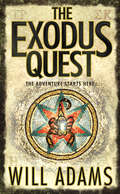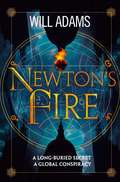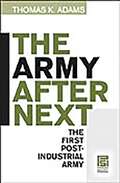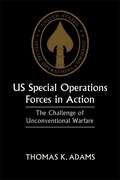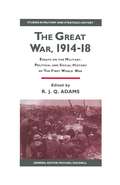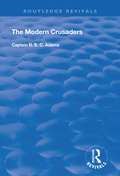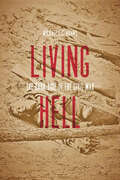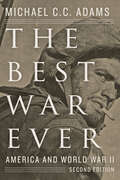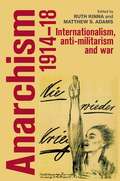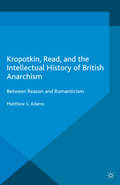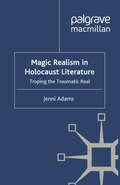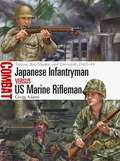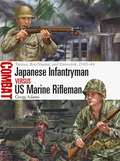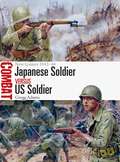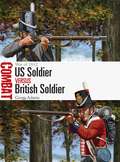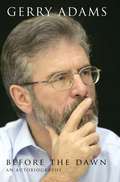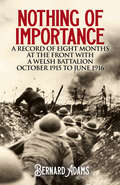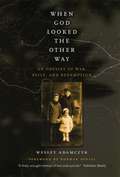- Table View
- List View
The Exodus Quest (Daniel Knox Ser. #2)
by Will AdamsFact collides with fiction in Will Adams second pulse-pounding adventure featuring the enigmatic Daniel Knox.
Newton’s Fire
by Will AdamsA breathtaking thriller which weaves history and religion with action, adventure and apocalypse…
The Army after Next: The First Postindustrial Army (Praeger Security International)
by Thomas K. AdamsThis book recounts the successes and failures of the US Army's Army Transformation program in the larger context of the Department of Defense's overall military transformation effort.Spurred by the belief that RMA represented the future, the Department of Defense (DoD) set out to transform the U.S. armed forces by adopting RMA concepts. Led by President George W. Bush and Defense Secretary Donald Rumsfeld, the DoD spent billions in an attempt to make the hypothetical capabilities real, changing the entire structure of the armed forces as a result. The services, the media, Congress, and the military industry each had its own agenda, all of which continue to come into play in the development of RMA strategies. The interplay of politics, technology, and military reality offers a fascinating narrative.Sure to be found controversial by some, compelling by all, this is the only available book-length examination of the way the U.S. Army and Department of Defense have tried to create the capabilities promised by the high-tech Revolution in Military Affairs. Of more immediate concern, it is also the only in-depth account of the effect RMA and transformation concepts had on the American operations in Afghanistan and Iraq. Many of the problems in both Iraq and Afghanistan, author Thomas K. Adams argues, arose from the DoD's implacable desire to implement RMA-driven transformation concepts—whether they were appropriate or not. What we need to do, he maintains, is to fight the war we have, not the war we want.
US Special Operations Forces in Action: The Challenge of Unconventional Warfare
by Thomas K. AdamsArmies in the 1990s are commonly involved in low-level, ill-defined, politically charged, messy situations known collectively as "unconventional warfare". Thomas Adams argues for a shift in expectations with a greater willingness to accept lengthy commitments and incremental progress.
US Special Operations Forces in Action: The Challenge of Unconventional Warfare
by Thomas K. AdamsArmies in the 1990s are commonly involved in low-level, ill-defined, politically charged, messy situations known collectively as "unconventional warfare". Thomas Adams argues for a shift in expectations with a greater willingness to accept lengthy commitments and incremental progress.
The Great War, 1914–18: Essays on the Military, Political and Social History of the First World War (Studies in Military and Strategic History)
by R. J. Q. AdamsThe Great War is a collection of seven original essays and three critical comments by senior scholars dealing with the greatest conflict in modern history to its time - the 1914-18 World War. The Great War is edited by the distinguished historian of the First World War, R.J.Q.Adams.
The Modern Crusaders (Routledge Revivals)
by R. E. AdamsOriginally published in 1920. The 231st Infantry Brigade, with which this diary is chiefly concerned, came into extence in January 1917, at a time when its compoent parts were engaged in the campaign against the Senussi, distributed in the Western Desert of Egypt and the Oases, from Sollum to Dakhala. The diary opens on October 1st 1917, when the preparations for the simultaneous attacks on Beersheba and Gaza were nearing completion.
The Modern Crusaders (Routledge Revivals)
by R. E. AdamsOriginally published in 1920. The 231st Infantry Brigade, with which this diary is chiefly concerned, came into extence in January 1917, at a time when its compoent parts were engaged in the campaign against the Senussi, distributed in the Western Desert of Egypt and the Oases, from Sollum to Dakhala. The diary opens on October 1st 1917, when the preparations for the simultaneous attacks on Beersheba and Gaza were nearing completion.
Living Hell: The Dark Side of the Civil War
by Michael C. C. AdamsMany Americans, argues Michael C. C. Adams, tend to think of the Civil War as more glorious, less awful, than the reality. Millions of tourists flock to battlefields each year as vacation destinations, their perceptions of the war often shaped by reenactors who work hard for verisimilitude but who cannot ultimately simulate mutilation, madness, chronic disease, advanced physical decay. In Living Hell, Adams tries a different tack, clustering the voices of myriad actual participants on the firing line or in the hospital ward to create a virtual historical reenactment.Perhaps because the United States has not seen conventional war on its own soil since 1865, the collective memory of its horror has faded, so that we have sanitized and romanticized even the experience of the Civil War. Neither film nor reenactment can fully capture the hard truth of the four-year conflict. Living Hell presents a stark portrait of the human costs of the Civil War and gives readers a more accurate appreciation of its profound and lasting consequences.Adams examines the sharp contrast between the expectations of recruits versus the realities of communal living, the enormous problems of dirt and exposure, poor diet, malnutrition, and disease. He describes the slaughter produced by close-order combat, the difficulties of cleaning up the battlefields;¢;‚¬;€?where tens of thousands of dead and wounded often lay in an area of only a few square miles;¢;‚¬;€?and the resulting psychological damage survivors experienced.Drawing extensively on letters and memoirs of individual soldiers, Adams assembles vivid accounts of the distress Confederate and Union soldiers faced daily: sickness, exhaustion, hunger, devastating injuries, and makeshift hospitals where saws were often the medical instrument of choice. Inverting Robert E. Lee;€™s famous line about war, Adams suggests that too many Americans become fond of war out of ignorance of its terrors. Providing a powerful counterpoint to Civil War glorification, Living Hell echoes William Tecumseh Sherman;€™s comment that war is cruelty and cannot be refined.Praise for Our Masters the Rebels: A Speculation on Union Military Failure in the East, 1861;€“1865"This excellent and provocative work concludes with a chapter suggesting how the image of Southern military superiority endured in spite of defeat.";¢;‚¬;€?Civil War History"Adams's imaginative connections between culture and combat provide a forceful reminder that Civil War military history belongs not in an encapsulated realm, with its own categories and arcane language, but at the center of the study of the intellectual, social, and psychological currents that prevailed in the mid-nineteenth century.";¢;‚¬;€?Journal of American HistoryPraise for The Best War Ever: America and World War II"Adams has a real gift for efficiently explaining complex historical problems.";¢;‚¬;€?Reviews in American History"Not only is this mythologizing bad history, says Adams, it is dangerous as well. Surrounding the war with an aura of nostalgia both fosters the delusion that war can cure our social ills and makes us strong again, and weakens confidence in our ability to act effectively in our own time.";¢;‚¬;€?Journal of Military History
The Best War Ever: America and World War II (The American Moment)
by Michael C. AdamsWas World War II really such a "good war"? Popular memory insists that it was, in fact, "the best war ever." After all, we knew who the enemy was, and we understood what we were fighting for. The war was good for the economy. It was liberating for women. A battle of tanks and airplanes, it was a "cleaner" war than World War I. Although we did not seek the conflictâ€�or so we believedâ€�Americans nevertheless rallied in support of the war effort, and the nation’s soldiers, all twelve million of them, were proud to fight. But according to historian Michael C. C. Adams, our memory of the war era as a golden age is distorted. It has left us with a misleadingâ€�even dangerousâ€�legacy, one enhanced by the nostalgia-tinged retrospectives of Stephen E. Ambrose and Tom Brokaw. Disputing many of our common assumptions about the period, Adams argues in The Best War Ever that our celebratory experience of World War II is marred by darker and more sordid realities. In the book, originally published in 1994, Adams challenges stereotypes to present a view of World War II that avoids the simplistic extremes of both glorification and vilification. The Best War Ever charts the complex diplomatic problems of the 1930s and reveals the realities of ground combat: no moral triumph, it was in truth a brutal slog across a blasted landscape. Adams also exposes the myth that the home front was fully united behind the war effort, demonstrating how class, race, gender, and age divisions split Americans. Meanwhile, in Europe and Asia, shell-shocked soldiers grappled with emotional and physical trauma, rigorously enforced segregation, and rampant venereal disease.In preparing this must-read new edition, Adams has consulted some seventy additional sources on topics as varied as the origins of Social Security and a national health system, the Allied strategic bombing campaign, and the relationship of traumatic brain injuries to the adjustment problems of veterans. The revised book also incorporates substantial developments that have occurred in our understanding of the course and character of the war, particularly in terms of the human consequences of fighting. In a new chapter, "The Life Cycle of a Myth," Adams charts image-making about the war from its inception to the present. He contrasts it with modern-day rhetoric surrounding the War on Terror, while analyzing the real-world consequences that result from distorting the past, including the dangerous idea that only through (perpetual) military conflict can we achieve lasting peace.
Anarchism, 1914–18: Internationalism, anti-militarism and war
by Matthew Adams Ruth KinnaA volume that focuses on the complex and multifaceted answers that the international anarchist movement gave to the outbreak of the First World War and its aftermaths and, in turn, the impact of the Great War on the anarchist movement.
Anarchism, 1914–18: Internationalism, anti-militarism and war
by Matthew Adams Ruth KinnaAnarchism 1914–18 is the first systematic analysis of anarchist responses to the First World War. It examines the interventionist debate between Peter Kropotkin and Errico Malatesta which split the anarchist movement in 1914 and provides a historical and conceptual analysis of debates conducted in European and American movements about class, nationalism, internationalism, militarism, pacifism and cultural resistance. Contributions discuss the justness of war, non-violence and pacifism, anti-colonialism, pro-feminist perspectives on war and the potency of myths about the war and revolution for the reframing of radical politics in the 1920s and beyond. Divisions about the war and the experience of being caught on the wrong side of the Bolshevik Revolution encouraged anarchists to reaffirm their deeply-held rejection of vanguard socialism and develop new strategies that drew on a plethora of anti-war activities.
Kropotkin, Read, and the Intellectual History of British Anarchism: Between Reason and Romanticism
by M. AdamsAlthough marginal as a political force, anarchist ideas developed in Britain into a political tradition. This book explores this lost history, offering a new appraisal of the work of Kropotkin and Read, and examining the ways in which they endeavoured to articulate a politics fit for the particular challenges of Britain's modern history.
Magic Realism in Holocaust Literature: Troping the Traumatic Real
by J. AdamsA major contribution to Holocaust studies, the book examines the capacity of supernatural elements to dramatize the ethical and representational difficulties of Holocaust fiction. Exploring texts by such writers as D.M. Thomas and Markus Zusak it will appeal to scholars and students of Holocaust literature, magic realism, and contemporary fiction.
Japanese Infantryman vs US Marine Rifleman: Tarawa, Roi-Namur, and Eniwetok, 1943–44 (Combat #75)
by Gregg AdamsFeaturing evocative artwork plates and carefully selected photographs, this book assesses the US Marines and Japanese troops who contested the islands of Tarawa, Roi-Namur, and Eniwetok during 1943–44. On November 20, 1943, amphibious vehicles carrying Marines of the 2d Marine Division reached the shores of Betio Island in the Tarawa Atoll, defended by a determined Japanese garrison that would fight to the last man. This began a test by combat of over two decades of US studies, analyses, and planning for capturing and defending naval bases in Micronesia. The Tarawa assault was followed in February 1944 by the rapid capture of the Kwajalein and Eniwetok atolls in the Marshall Islands. In these battles US Marines fought a mix of Imperial Japanese Navy and Imperial Japanese Army ground units. All but a handful of the defenders, whether they were organized ground combat troops or infantry improvised from aviators and service troops, were determined to die for the Emperor while killing as many of the enemy as possible. In this study, Gregg Adams shows how the US Marine Corps and US Navy drew upon these pivotal actions to improve their tactics, organization, and equipment for the next round of amphibious operations. He also explains how their Japanese opponents – realizing that isolated island garrisons were doomed to destruction or isolation if the Imperial Japanese Navy could not defeat the US Navy at sea – moved from seeking to repel an invasion to one inflicting maximum American casualties through prolonged defensive fighting.
Japanese Infantryman vs US Marine Rifleman: Tarawa, Roi-Namur, and Eniwetok, 1943–44 (Combat #75)
by Gregg AdamsFeaturing evocative artwork plates and carefully selected photographs, this book assesses the US Marines and Japanese troops who contested the islands of Tarawa, Roi-Namur, and Eniwetok during 1943–44. On November 20, 1943, amphibious vehicles carrying Marines of the 2d Marine Division reached the shores of Betio Island in the Tarawa Atoll, defended by a determined Japanese garrison that would fight to the last man. This began a test by combat of over two decades of US studies, analyses, and planning for capturing and defending naval bases in Micronesia. The Tarawa assault was followed in February 1944 by the rapid capture of the Kwajalein and Eniwetok atolls in the Marshall Islands. In these battles US Marines fought a mix of Imperial Japanese Navy and Imperial Japanese Army ground units. All but a handful of the defenders, whether they were organized ground combat troops or infantry improvised from aviators and service troops, were determined to die for the Emperor while killing as many of the enemy as possible. In this study, Gregg Adams shows how the US Marine Corps and US Navy drew upon these pivotal actions to improve their tactics, organization, and equipment for the next round of amphibious operations. He also explains how their Japanese opponents – realizing that isolated island garrisons were doomed to destruction or isolation if the Imperial Japanese Navy could not defeat the US Navy at sea – moved from seeking to repel an invasion to one inflicting maximum American casualties through prolonged defensive fighting.
Japanese Soldier vs US Soldier: New Guinea 1942–44 (Combat)
by Gregg AdamsThis absorbing study pits US Army National Guardsmen against Japanese soldiers in the uniquely hostile setting of the New Guinea campaign in World War II.When Japanese forces attacked Pearl Harbor in December 1941, New Guinea – the world's second-largest island – was administered partly by Australia and partly by the Dutch East Indies. The New Guinea campaign (January 1942–August 1945) saw Japanese forces invade the island, rapidly capturing the key port of Rabaul and threatening Port Moresby, while US forces joined the defenders in increasing numbers. The uniquely demanding environment, and the savage nature of the fighting, meant that the campaign was among the most arduous of World War II for both sides. In this study, the Japanese forces and their US Army opponents, many of whom were National Guard units, are assessed and compared, with particular attention paid to combat doctrine, weaponry, tactics, logistics, leadership, and communications in the challenging setting of New Guinea. The role of US Army National Guard units and their Japanese opponents in three important battles are examined, namely Buna–Gona (November 1942–January 1943), Biak Island (May–August 1944) and the Driniumor River (July–August 1944).
Japanese Soldier vs US Soldier: New Guinea 1942–44 (Combat)
by Gregg AdamsThis absorbing study pits US Army National Guardsmen against Japanese soldiers in the uniquely hostile setting of the New Guinea campaign in World War II.When Japanese forces attacked Pearl Harbor in December 1941, New Guinea – the world's second-largest island – was administered partly by Australia and partly by the Dutch East Indies. The New Guinea campaign (January 1942–August 1945) saw Japanese forces invade the island, rapidly capturing the key port of Rabaul and threatening Port Moresby, while US forces joined the defenders in increasing numbers. The uniquely demanding environment, and the savage nature of the fighting, meant that the campaign was among the most arduous of World War II for both sides. In this study, the Japanese forces and their US Army opponents, many of whom were National Guard units, are assessed and compared, with particular attention paid to combat doctrine, weaponry, tactics, logistics, leadership, and communications in the challenging setting of New Guinea. The role of US Army National Guard units and their Japanese opponents in three important battles are examined, namely Buna–Gona (November 1942–January 1943), Biak Island (May–August 1944) and the Driniumor River (July–August 1944).
US Soldier vs British Soldier: War of 1812 (Combat)
by Gregg AdamsBetween June 1812 and January 1815, US and British forces, notably the regular infantrymen of both sides (including the Canadian Fencibles Regiment), fought one another on a host of North American battlefields. This study examines the evolving role and combat performance of the two sides' regulars during the conflict, with particular reference to three revealing battles in successive years: Queenston Heights, Crysler's Farm, and Chippawa.Featuring full-color artwork and battle maps, this fully illustrated study investigates the US and British regular infantry's role, tactics, junior leadership, and combat performance on three battlefields of the War of 1812. The actions assessed here notably demonstrate the evolution of US regulars from their initial poor showing to an emerging professionalism that allowed them to face their British opponents on equal terms.
US Soldier vs British Soldier: War of 1812 (Combat)
by Gregg AdamsBetween June 1812 and January 1815, US and British forces, notably the regular infantrymen of both sides (including the Canadian Fencibles Regiment), fought one another on a host of North American battlefields. This study examines the evolving role and combat performance of the two sides' regulars during the conflict, with particular reference to three revealing battles in successive years: Queenston Heights, Crysler's Farm, and Chippawa.Featuring full-color artwork and battle maps, this fully illustrated study investigates the US and British regular infantry's role, tactics, junior leadership, and combat performance on three battlefields of the War of 1812. The actions assessed here notably demonstrate the evolution of US regulars from their initial poor showing to an emerging professionalism that allowed them to face their British opponents on equal terms.
Before the Dawn: An Autobiography
by Gerry AdamsThe controversial autobiography of the man at the heart of Irish Republican politics. Sinn Fein leader Gerry Adams offers his own unique, intimate account of the early years of his career, from his childhood in working-class Belfast to the more turbulent years of social activism that followed. An engaging and revealing self-portrait. Born in West Belfast in 1948 into a family with close ties to both the trade union and republican movements, his childhood, despite its material poverty, he has described in glowing and humorous terms. For many years his voice was banned from radio and television by both the British and Irish governments, while commentators and politicians condemned him and all he stood for. But through those years Brandon published a succession of books which made an important contribution to an understanding of the true circumstances of life and politics in the north of Ireland. In his autobiography, Before the Dawn, Gerry Adams brings a unique perspective to the years of conflict, insurrection and bitter struggle which ensued when peaceful political agitation was met with hysterical reaction and the sectarian tinderbox of Britain's last colony erupted. From the pogroms of 1969 to the hunger strikes of 1981, from the streets of West Belfast to the cages of Long Kesh, his powerful memoir is essential reading for anyone wishing to understand modern Ireland.
Nothing of Importance: A Record of Eight Months at the Front with a Welsh Battalion - October 1915 to June 1916
by Bernard Adams'In this war there is nothing more terrible than the truth.'In this poignant personal narrative, Bernard Adams provides an authentic account of a soldier's life on the front lines during World War I. He relates the boredom and weariness of life in the trenches, the fellowships formed between the soldiers who fought, and the sudden and shocking terrors of battle.This exceptionally detailed account covers everything from the art of sniping to the actions of a working party and the nature of patrols.In a tragic turn of events, the author died from his wounds before the book was published. His work stands as a testament to the many soldiers who gave their lives in that terrible conflict.
When God Looked the Other Way: An Odyssey of War, Exile, and Redemption (Nber - Macroeconomics Annual Ser.)
by Wesley AdamczykOften overlooked in accounts of World War II is the Soviet Union's quiet yet brutal campaign against Polish citizens, a campaign that included, we now know, war crimes for which the Soviet and Russian governments only recently admitted culpability. Standing in the shadow of the Holocaust, this episode of European history is often overlooked. Wesley Adamczyk's gripping memoir, When God Looked the Other Way, now gives voice to the hundreds of thousands of victims of Soviet barbarism. Adamczyk was a young Polish boy when he was deported with his mother and siblings from their comfortable home in Luck to Soviet Siberia in May of 1940. His father, a Polish Army officer, was taken prisoner by the Red Army and eventually became one of the victims of the Katyn massacre, in which tens of thousands of Polish officers were slain at the hands of the Soviet secret police. The family's separation and deportation in 1940 marked the beginning of a ten-year odyssey in which the family endured fierce living conditions, meager food rations, chronic displacement, and rampant disease, first in the Soviet Union and then in Iran, where Adamczyk's mother succumbed to exhaustion after mounting a harrowing escape from the Soviets. Wandering from country to country and living in refugee camps and the homes of strangers, Adamczyk struggled to survive and maintain his dignity amid the horrors of war. When God Looked the Other Way is a memoir of a boyhood lived in unspeakable circumstances, a book that not only illuminates one of the darkest periods of European history but also traces the loss of innocence and the fight against despair that took root in one young boy. It is also a book that offers a stark picture of the unforgiving nature of Communism and its champions. Unflinching and poignant, When God Looked the Other Way will stand as a testament to the trials of a family during wartime and an intimate chronicle of episodes yet to receive their historical due. “Adamczyk recounts the story of his own wartime childhood with exemplary precision and immense emotional sensitivity, presenting the ordeal of one family with the clarity and insight of a skilled novelist. . . . I have read many descriptions of the Siberian odyssey and of other forgotten wartime episodes. But none of them is more informative, more moving, or more beautifully written than When God Looked the Other Way.”—From the Foreword by Norman Davies, author of Europe: A History and Rising ’44: The Battle for Warsaw “A finely wrought memoir of loss and survival.”—Publishers Weekly “Adamczyk’s unpretentious prose is well-suited to capture that truly awful reality.” —Andrew Wachtel, Chicago Tribune Books “Mr. Adamczyk writes heartfelt, straightforward prose. . . . This book sheds light on more than one forgotten episode of history.”—Gordon Haber, New York Sun “One of the most remarkable World War II sagas I have ever read. It is history with a human face.”—Andrew Beichman, Washington Times
When God Looked the Other Way: An Odyssey of War, Exile, and Redemption
by Wesley AdamczykOften overlooked in accounts of World War II is the Soviet Union's quiet yet brutal campaign against Polish citizens, a campaign that included, we now know, war crimes for which the Soviet and Russian governments only recently admitted culpability. Standing in the shadow of the Holocaust, this episode of European history is often overlooked. Wesley Adamczyk's gripping memoir, When God Looked the Other Way, now gives voice to the hundreds of thousands of victims of Soviet barbarism. Adamczyk was a young Polish boy when he was deported with his mother and siblings from their comfortable home in Luck to Soviet Siberia in May of 1940. His father, a Polish Army officer, was taken prisoner by the Red Army and eventually became one of the victims of the Katyn massacre, in which tens of thousands of Polish officers were slain at the hands of the Soviet secret police. The family's separation and deportation in 1940 marked the beginning of a ten-year odyssey in which the family endured fierce living conditions, meager food rations, chronic displacement, and rampant disease, first in the Soviet Union and then in Iran, where Adamczyk's mother succumbed to exhaustion after mounting a harrowing escape from the Soviets. Wandering from country to country and living in refugee camps and the homes of strangers, Adamczyk struggled to survive and maintain his dignity amid the horrors of war. When God Looked the Other Way is a memoir of a boyhood lived in unspeakable circumstances, a book that not only illuminates one of the darkest periods of European history but also traces the loss of innocence and the fight against despair that took root in one young boy. It is also a book that offers a stark picture of the unforgiving nature of Communism and its champions. Unflinching and poignant, When God Looked the Other Way will stand as a testament to the trials of a family during wartime and an intimate chronicle of episodes yet to receive their historical due. “Adamczyk recounts the story of his own wartime childhood with exemplary precision and immense emotional sensitivity, presenting the ordeal of one family with the clarity and insight of a skilled novelist. . . . I have read many descriptions of the Siberian odyssey and of other forgotten wartime episodes. But none of them is more informative, more moving, or more beautifully written than When God Looked the Other Way.”—From the Foreword by Norman Davies, author of Europe: A History and Rising ’44: The Battle for Warsaw “A finely wrought memoir of loss and survival.”—Publishers Weekly “Adamczyk’s unpretentious prose is well-suited to capture that truly awful reality.” —Andrew Wachtel, Chicago Tribune Books “Mr. Adamczyk writes heartfelt, straightforward prose. . . . This book sheds light on more than one forgotten episode of history.”—Gordon Haber, New York Sun “One of the most remarkable World War II sagas I have ever read. It is history with a human face.”—Andrew Beichman, Washington Times
When God Looked the Other Way: An Odyssey of War, Exile, and Redemption (Nber - Macroeconomics Annual Ser.)
by Wesley AdamczykOften overlooked in accounts of World War II is the Soviet Union's quiet yet brutal campaign against Polish citizens, a campaign that included, we now know, war crimes for which the Soviet and Russian governments only recently admitted culpability. Standing in the shadow of the Holocaust, this episode of European history is often overlooked. Wesley Adamczyk's gripping memoir, When God Looked the Other Way, now gives voice to the hundreds of thousands of victims of Soviet barbarism. Adamczyk was a young Polish boy when he was deported with his mother and siblings from their comfortable home in Luck to Soviet Siberia in May of 1940. His father, a Polish Army officer, was taken prisoner by the Red Army and eventually became one of the victims of the Katyn massacre, in which tens of thousands of Polish officers were slain at the hands of the Soviet secret police. The family's separation and deportation in 1940 marked the beginning of a ten-year odyssey in which the family endured fierce living conditions, meager food rations, chronic displacement, and rampant disease, first in the Soviet Union and then in Iran, where Adamczyk's mother succumbed to exhaustion after mounting a harrowing escape from the Soviets. Wandering from country to country and living in refugee camps and the homes of strangers, Adamczyk struggled to survive and maintain his dignity amid the horrors of war. When God Looked the Other Way is a memoir of a boyhood lived in unspeakable circumstances, a book that not only illuminates one of the darkest periods of European history but also traces the loss of innocence and the fight against despair that took root in one young boy. It is also a book that offers a stark picture of the unforgiving nature of Communism and its champions. Unflinching and poignant, When God Looked the Other Way will stand as a testament to the trials of a family during wartime and an intimate chronicle of episodes yet to receive their historical due. “Adamczyk recounts the story of his own wartime childhood with exemplary precision and immense emotional sensitivity, presenting the ordeal of one family with the clarity and insight of a skilled novelist. . . . I have read many descriptions of the Siberian odyssey and of other forgotten wartime episodes. But none of them is more informative, more moving, or more beautifully written than When God Looked the Other Way.”—From the Foreword by Norman Davies, author of Europe: A History and Rising ’44: The Battle for Warsaw “A finely wrought memoir of loss and survival.”—Publishers Weekly “Adamczyk’s unpretentious prose is well-suited to capture that truly awful reality.” —Andrew Wachtel, Chicago Tribune Books “Mr. Adamczyk writes heartfelt, straightforward prose. . . . This book sheds light on more than one forgotten episode of history.”—Gordon Haber, New York Sun “One of the most remarkable World War II sagas I have ever read. It is history with a human face.”—Andrew Beichman, Washington Times
